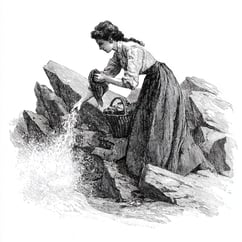Before stainless-steel drums and push-button cycles, laundry was about as glamorous as mud wrestling. It actually was a bit like mud wrestling! Humans have always wanted clean clothes in the easiest possible way, but how we got there has been a long march of bruised knuckles, scalded fingers, and some serious engineering genius.
Where it Began - Beating Clothes on Rocks 
In the earliest days, laundry meant dragging clothes to the nearest riverbank and whacking them against rocks. Effective? Surprisingly. Gentle? Absolutely not. It was laundry by brute force, and fabrics wore out much faster than the people beating them. Delicate fabrics were simply not an option - they couldn't withstand the beatings.
Enter the Washboard 
By the 1700s, wooden and metal washboards turned the riverbank into a more “at home” job. Instead of rocks on rivers, clothes were scrubbed across ridged boards. Still exhausting, still hard on fabric, but at least you didn’t need to stand ankle-deep in cold water while you did it.
The Hot Tub and Tongs Era 
By the 1800s, laundry day meant giant tubs of boiling water, bars of lye soap, and a pair of wooden tongs. Clothes were boiled to kill germs and lift stains, then hauled out and wrung by hand. Doing laundry wasn't for the faint-hearted... and was still incredibly time-consuming.
.png?width=215&height=215&name=_cyborgalpha_a_wringer_squeezing_water_out_of_a_blanket_--v_7_ffa12b93-6525-4220-831d-b89aea61185f_1%20(1).png) The Wringer Revolution
The Wringer Revolution
In the mid-1800s inventors added the first mechanical assist: the wringer. A true revolution, two rollers squeezed water from fabric, saving some hand-twisting misery. Wringers drastically reduced drying time for minimal effort - because they extracted so much more water from garments. Of course, wringers also squeezed fingers if you weren’t careful... plenty of laundry workers had bruises to prove it.
Then Came the Electric Dreams 
By the early 1900s, the revolution of electricity made it's way into the laundry room. The first powered washers were actually fuel motors - but quickly were replaced by electric models. This meant clothes could finally be agitated mechanically instead of by human muscle. In 1911, Speed Queen rolled out one of the first electric-powered machines, kicking off a century of “push a button, walk away" washing.
The Age of Automation 
The mid-20th century brought fully automatic washers and dryers: fill, wash, rinse, spin, dry — all with minimal human effort. Suddenly, “laundry day” started looking less like a battlefield and more like a household routine. Full of automatic sensors, devices got smarter and smarter.
Where We Are Now
Today, Speed Queen carries that innovative legacy into the next era. Washers and dryers aren’t just faster (a full wash in ~30–40 minutes, a dry in about the same), they’re tougher, smarter, and built for decades of use. Cloud connection via Speed Queen Insights enables remote visibility and management of washers (and dryers). Automatic chemical dosing ensures precise delivery of detergents and disinfectants.
The future? Maybe we'll all end up with AI robots to do washing for us? Those robots will still need a reliable, tough and efficient washer to put them in!
The Thread That Ties It Together
Laundry innovation has always been about two things: saving time and saving effort. From rocks to wringers to high-speed spins, every step forward gave people a little more of their life back.
Speed Queen didn’t invent the need for clean clothes — we are just perfecting the way we get them.
Want to find out how we can help you do smarter things with your commercial laundry?

